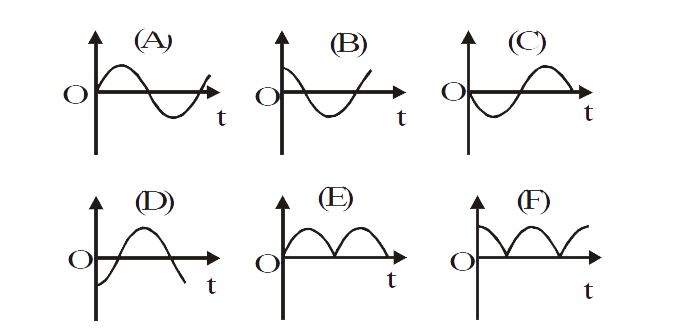The displacement of a particle in an SHM in one time period is
A
2A
4A
zero
The correct Answer is:D
To solve the question regarding the displacement of a particle in Simple Harmonic Motion (SHM) over one time period, we can follow these steps:
1. Understanding SHM:
- In SHM, a particle oscillates back and forth around a mean position (equilibrium position). The particle moves between two extreme positions, known as the amplitude positions (let's call them A and B).
2. Defining the Time Period:
- The time period (T) is the time taken for the particle to complete one full cycle of motion. This means the particle moves from one extreme position (A) to the other extreme position (B) and then returns back to the starting position (A).
3. Analyzing the Motion:
- If we consider the motion of the particle:
- It starts at position A (one extreme), moves to position B (the other extreme), and then returns to position A.
- During this entire motion, the particle travels a distance but returns to its original position.
4. Calculating Displacement:
- Displacement is defined as the change in position of the particle. It is a vector quantity that considers both magnitude and direction.
- Since the particle starts at position A and ends at position A after one complete cycle, the net change in position is zero.
5. Conclusion:
- Therefore, the displacement of the particle in one complete time period is zero.
Final Answer:
The displacement of a particle in SHM in one time period is 0.
---
- In SHM, a particle oscillates back and forth around a mean position (equilibrium position). The particle moves between two extreme positions, known as the amplitude positions (let's call them A and B).
- The time period (T) is the time taken for the particle to complete one full cycle of motion. This means the particle moves from one extreme position (A) to the other extreme position (B) and then returns back to the starting position (A).
- If we consider the motion of the particle:
- It starts at position A (one extreme), moves to position B (the other extreme), and then returns to position A.
- During this entire motion, the particle travels a distance but returns to its original position.
- Displacement is defined as the change in position of the particle. It is a vector quantity that considers both magnitude and direction.
- Since the particle starts at position A and ends at position A after one complete cycle, the net change in position is zero.
- Therefore, the displacement of the particle in one complete time period is zero.
The displacement of a particle in SHM in one time period is 0.
Topper's Solved these Questions
- SIMPLE HARMONIC MOTIONBOOK - FIITJEECHAPTER - SIMPLE HARMONIC MOTIONEXERCISE - Assignment Problems (Objective) (Level-I) (Assertion Reasoning type)
3 Videos
- SIMPLE HARMONIC MOTIONBOOK - FIITJEECHAPTER - SIMPLE HARMONIC MOTIONEXERCISE - Assignment Problems (Objective) (Level-II)
20 Videos
- SIMPLE HARMONIC MOTIONBOOK - FIITJEECHAPTER - SIMPLE HARMONIC MOTIONEXERCISE - Assignment Problems (Subjective) (Level-II & III)
13 Videos
- SEMICONDUCTOR AND DEVICEBOOK - FIITJEECHAPTER - SEMICONDUCTOR AND DEVICEEXERCISE - SOLVED PROBLEMS Objective: Level-I
20 Videos
- TEST PAPERSBOOK - FIITJEECHAPTER - TEST PAPERSEXERCISE - PHYSICS
747 Videos
Similar Questions
Knowledge Check
The displacement of a particle in S.H.M. in one time period is
AAB2AC4ADZeroA particle executes simple harmonic motion. The amplitude of vibration of particle is 2 cm. The displacement of particle in one time period is
A1 cmB2 cmC4 cmDzeroThe displacement of a particle executing SHM at any time t (Seconds) is x=0.01sin100π(t=0.005) then its time period will be
A0.2sB0.1sC0.06sD0.02s
The displacement of a particle in SHM is indicated by equation y=10sin(20t+π/3) where, y is in metres. The value of time period of vibration will be (in second)
View SolutionIf x,v and a denote the displacement, the velocity and the acceleration of a particle executing simple harmonic motion of time period T, then, which of the following does not change with time ?
View SolutionThe displacement of a particle executing S.H.M is given by x=0.01sin100π(t+0.05). The time period is
View SolutionThe displacement of a particle executing SHM is given by
Y=5 sin (4t+π3)
If T is the time period and the mass of the particle is 2g, the kinetic energy of the particle When t=T4 is given by-
View SolutionThe equation of motion of a particle in SHM is a+16π2x=0. Here 'a' is linear acceleration of the particle at displacement x(a,x are in SI). Its time period is
View Solution

